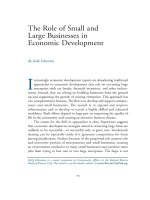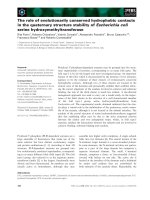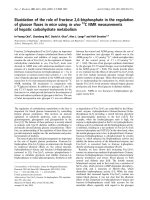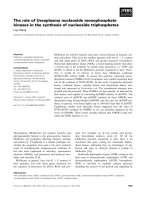The role of BLNK, DOK 3 DIP in BCR signaling 1
Bạn đang xem bản rút gọn của tài liệu. Xem và tải ngay bản đầy đủ của tài liệu tại đây (3.75 MB, 234 trang )
THE ROLE OF BLNK, DOK-3 & DIP IN BCR SIGNALING
JOY EN-LIN TAN
(B.Biotech.(Hons.))
A THESIS SUBMITTED
FOR THE DEGREE OF DOCTOR OF PHILOSOPHY
INSTITUTE OF MOLECULAR AND CELL BIOLOGY
NATIONAL UNIVERSITY OF SINGAPORE
2004
ACKNOWLEDGMENT
I
ACKNOWLEDGMENT
I would like to thank the following people who made this thesis possible and an
enjoyable experience for me.
I am indebted to my supervisor A/P Lam Kong Peng, for his support and guidance as
well as giving me an opportunity to work in his laboratory. Without his help, this
work would not have been possible. I would also like to thank the members of my
committee, A/P Benjamin Li and Assist. Prof. Robert Qi for their constructive
suggestions and discussion. I am also grateful to Assist. Prof. Tang Bor Luen, who so
kindly provided invaluable suggestions and gave immense support and
encouragement.
Special thanks goes to my past and present colleagues in the Molecular and Cellular
Immunology Laboratory of the Institute of Molecular and Cell Biology (IMCB). In
particular, Dr. Xu Shengli, who generated the BLNK-deficient mice, together with his
advice, friendship and constant encouragements. Dr. Wong Siew Cheng, who taught
me how to perform western analysis and gel-shift experiments and provided valuable
suggestions and discussions. Mr. Chew Weng Keong, Mr. Lee Koon Guan, Ms. Tan
Su-Li, Ms. Tan Ai-Tee for their excellent help through the various years in
maintaining the laboratory. Fellow comrades in the laboratory Mr. Ng Chee Hoe, Mr.
Andy Tan, Ms. Valerie Chew for making the laboratory a friendlier place to be in. I
ACKNOWLEDGMENT
II
would also like to acknowledge the staff of the In Vivo Model Systems Unit of IMCB
for taking care of the mice.
I would like to thank my friends at IMCB especially Darren, Boon Tin, Zhihong and
Esther for those fun times studying and working together.
I am also grateful to the Administrative Staff, the COMIT Staff, the Lab-Supply Staff,
the Maintenance Staff and the Glass-Ware Staff who tirelessly helped made my work
much easier at IMCB.
I would like to thank my family for their constant support. I am greatly indebted to
my parents who helped me each day with encouragements and advices and my
brother who never stop believing in me. Above all, my husband, John who
encouraged me to persevere on even though there were times when things were
tough. Thank you for your constant love, unfailing support and everlasting
understanding.
Lastly, I would like to attribute all glory to God for this was only made possible
because of Him.
I dedicate this thesis to my mother and father.
Joy En-Lin Tan
July 2004
TABLE OF CONTENTS
III
TABLE OF CONTENTS
ACKNOWLEDGMENT I
TABLE OF CONTENTS III
LIST OF FIGURES IX
ABBREVIATIONS XI
SUMMARY XIII
LIST OF PUBLICATIONS XVI
CHAPTER 1: INTRODUCTION 1
1.1 THE IMMUNE SYSTEM 2
1.2 DEVELOPMENT OF B LYMPHOCYTES 4
1.2.1 Immunoglobulin gene rearrangement 5
1.3 MATURATION OF B LYMPHOCYTE REGULATED BY BCR AND
THEIR SURROGATES
6
1.3.1 Development of pro- and pre-B lymphocytes 8
1.3.2 Immature B lymphocytes undergo negative selection 9
1.3.3 Transitional B lymphocytes develop into mature B lymphocytes 11
1.3.4 Functional maturation of periphery B lymphocytes 12
1.3.4.1 T cell-dependent immune response 13
1.3.4.2 T cell-independent immune response 14
1.4 ANTIGEN RECEPTORS SIGNALING IN B LYMPHOCYTES 15
1.4.1 Structure of B cell receptor 15
1.4.2 Signal transduction through the B cell receptor 17
1.4.2.1 Protein tyrosine kinases 18
1.4.2.1.1 Activation of src protein tyrosine kinases 18
1.4.2.1.2 Membrane recruitment and activation of syk 20
1.4.2.1.3 Activation of Bruton’s tec kinase 21
TABLE OF CONTENTS
IV
1.4.2.2 Protein tyrosine phosphatases 22
1.4.2.2.1 CD45 required for BCR signaling 22
1.4.2.2.2 Lipid phosphatase 5’ inositol phosphatase (SHIP-1) 23
1.4.3 Structure of co-BCR receptor Fc
γ
RIIB 23
1.4.3.1 FcγRIIB mediated inhibition 24
1.4.4 Major downstream signaling pathways of BCR 26
1.4.4.1 Activation of the PI3-K pathway 26
1.4.4.2 Activation of phospholipase C (PLCγ) pathway 30
1.4.4.3 Activation of the Rho-family GTPase 32
1.4.4.4 Activation of the Ras signaling pathway 33
1.5 LIPID RAFTS IN BCR SIGNALING 34
1.6 REGULATION OF BCR SIGNALING BY ADAPTOR PROTEINS 37
1.6.1 Domains and motifs found in adaptor proteins 37
1.6.2 Adaptor proteins in BCR signaling 38
1.6.2.1 Adaptors involved in positive regulation of BCR signaling 39
1.6.2.1.1 Bam32 39
1.6.2.1.2 BCAP 40
1.6.2.1.3 BLNK 41
1.6.2.2 Adaptors involved in negative regulation of BCR signaling 43
1.6.2.2.1 c-Cbl 43
1.6.2.2.2 Dok 43
1.7 APOPTOSIS IN B-LYMPHOCYTE DEVELOPMENT 45
1.8 AIMS AND RATIONALE OF CURRENT RESEARCH 47
CHAPTER 2: MATERIAL AND METHODS 48
2.1 LIST OF ANTIBODIES 49
2.2 LIST OF PRIMERS 51
2.3 RNA/DNA METHODOLOGY 53
2.3.1 Extraction of RNA 53
2.3.2 Northern analysis 54
2.3.3 First strand cDNA synthesis 55
2.3.4 Amplification of cDNA 56
2.3.5 Polymerase chain reaction (PCR) 57
2.3.6 Agarose gel electrophoresis 59
2.3.7 Elution of DNA from agarose gel 59
TABLE OF CONTENTS
V
2.3.8 Restriction enzymes (RE) digestion of plasmid DNA 60
2.3.9 Dephosphorylation of plasmid DNA 60
2.3.10 Ligation 61
2.3.11 Preparation of competent cells, DH5
α
61
2.3.12 Bacterial transformation by the heat shock protocol 62
2.3.13 Mini-preparation of plasmid DNA by alkaline lysis 62
2.3.14 Maxi-preparation of plasmid DNA 63
2.3.15 Sequencing of DNA 64
2.4 PROTEIN METHODOLOGY 65
2.4.1 Yeast-two-hybrid screen 65
2.4.1.1 Synthetic dropout (SD) solution 65
2.4.1.2 Small-scale yeast transformation using LiAc 66
2.4.1.3 Preparation of DNA-BD-GAL4 bait for mating 68
2.4.1.4 Mating of pre-transformed library with bait 68
2.4.1.5 β-galactosidase colony-lift filter assay 69
2.4.2 Protein concentration determination by BCA protein assay 69
2.4.3 Western blot analysis 70
2.4.4 Alkaline phosphatase assay 71
2.4.5 Immunoprecipitation 71
2.4.6 Indirect immunofluorescent labelling 71
2.4.6 Transient transfection methods 72
2.4.6.1 Lipofectamine transfection 72
2.4.6.2 Effectene transfection 73
2.4.6.3 Amaxa transfection 73
2.4.7 Lipid raft separation 74
2.4.8 NF-
κ
B assays 74
2.4.8.1 Stimulation of cells for NF-κB assays 74
2.4.8.2 Preparation of nuclear extracts 75
2.4.8.3 Electrophoretic mobility shift assays 75
2.5 MAMMALIAN CELL CULTURE AND ASSAYS 76
2.5.1 Cell culture 76
2.5.2 Apoptosis assay 76
2.5.3 Preparation of primary B cells from mouse spleen 77
2.5.4 Cell proliferation assay 77
TABLE OF CONTENTS
VI
2.5.5 Cell cycle and cell death analyses 78
CHAPTER 3: THE ROLE OF ADAPTOR PROTEIN BLNK IN
BCR SIGNALING OF CELL CYCLE PROGRESSION AND
SURVIVAL IN B LYMPHOCYTES 79
3.1 INTRODUCTION 80
3.2 ANTI-IGM STIMULATED BLNK
-/-
B CELLS FAIL TO ENTER THE
CELL CYCLE
81
3.3 IMPAIRED INDUCTION OF CELL CYCLE REGULATORY PROTEINS
IN ANTI
-IGM STIMULATED BLNK
-/-
B CELLS 86
3.4 BLNK
-/-
B CELLS DO NOT EXPRESS BCL-X
L
UPON ANTI-IGM
STIMULATION
88
3.5 BLNK
-/-
B CELLS EXHIBIT A HIGH RATE OF SPONTANEOUS
APOPTOSIS IN CULTURE
89
3.6 NORMAL ACTIVATION OF MAPKS AND AKT IN MOUSE BLNK
-/-
B CELLS 94
3.7 BLNK IS REQUIRED FOR THE ACTIVATION OF NF-κB IN
RESPONSE TO
BCR ENGAGEMENT 96
3.8 THE ACTIVATION OF BRUTON’S TYROSINE KINASE IS NORMAL
BUT THAT OF
PLC-γ2 IS IMPAIRED IN BCR-STIMULATED
BLNK
-/-
B CELLS 102
3.9 DISCUSSION 105
CHAPTER 4: THE ROLE OF DOK-3 IN NEGATIVE
REGULATION OF BCR SIGNALING 113
4.1 INTRODUCTION 114
TABLE OF CONTENTS
VII
4.2 PHOSPHORYLATION OF DOK-3 UPON BCR AND FCγRIIB CO-
LIGATION 117
4.3 LIPID RAFT LOCALIZATION OF DOK-3 UPON BCR + FCγRIIB
CO
-LIGATION 119
4.4 LIPID RAFT LOCALIZATION OF DOK-3 IS PERTURBED BY
BLOCKING
FCγRIIB 126
4.5 DISCUSSION 126
CHAPTER 5: CHARACTERIZATION OF A DOK-3-
INTERACTING
PROTEIN, DIP 130
5.1 INTRODUCTION 131
5.2 CLONING OF FULL LENGTH DOK-3 CDNA AND IDENTIFICATION
OF A
DOK-3-INTERACTING PROTEIN, DIP 132
5.3 INTERACTION OF DOK-3 AND DIP ANALYSED BY CO-
TRANSFECTION STUDIES 135
5.4 TISSUE EXPRESSION PROFILE OF DIP 139
5.5 SUBCELLULAR LOCALIZATION OF DIP IN RESTING AND
ACTIVATED CELLS
143
5.6 CO-LOCALIZATION OF DIP AND DOK-3 TO LIPID RAFTS UPON
BCR + FCR CO-LIGATION 146
5.7 DIP BINDS TO DOK-3 THROUGH ITS C-TERMINAL DOMAIN IN A
PHOSPHORYLATION
-INDEPENDENT MANNER 150
5.8 INTERACTION OF DIP WITH SPECIFIC MEMBERS OF THE DOK
FAMILY ADAPTORS
151
5.9 DIP MEDIATES APOPTOSIS THROUGH A CASPASE-3 DEPENDENT
MECHANISM
154
TABLE OF CONTENTS
VIII
5.10 DOK-3 AND DOK-1 INHIBITS DIP-MEDIATED APOPTOSIS 159
5.11 DISCUSSION 162
CHAPTER 6 GENERAL CONCLUSION 166
6.1 IMPORTANCE OF POSITIVE REGULATOR ADAPTOR BLNK IN
BCR SIGNALING 167
6.2 THE ROLE OF DOK-3 IN NEGATIVE REGULATION OF BCR
SIGNALING
168
REFERENCES 170
PUBLICATIONS 199
LIST OF FIGURES
IX
LIST OF FIGURES
Figure 1.1 B lymphocyte development. 7
Figure 1.2 Structure of the BCR complex 16
Figure 1.3 Activation of proximal PTKs upon BCR engagement 19
Figure 1.4 Signaling of B lymphocyte inhibitory receptor, FcγRIIB 25
Figure 1.5 Major downstream signaling pathways of BCR. 28
Figure 1.6 A schematic view of BLNK protein domains 42
Figure 3.1 Defective proliferation of BLNK
-/-
B cells in response to anti-IgM
but not LPS stimulation 83
Figure 3.2 Anti-IgM-stimulated BLNK
-/-
B cells failed to enter the cell cycle.
84
Figure 3.3 Lack of induction of cell cycle regulatory proteins in anti-IgM-
stimulated BLNK
-/-
B cells 87
Figure 3.4 Absence of Bcl-x
L
expression in anti-IgM-stimulated BLNK
-/-
B
cells. 90
Figure 3.5 The expression of Bcl-2 is not altered in wild-type and BLNK
-/-
B
cells treated with various stimuli 91
Figure 3.6 High rate of spontaneous apoptosis of BLNK
-/-
B cells in culture.93
Figure 3.7 BLNK
-/-
B cells exhibited normal activation of MAPKs and Akt
upon BCR engagement 95
Figure 3.8 Imparied NF-κB activation in BCR-stimulated BLNK
-/-
B cells. 100
Figure 3.9 Expression and activation of Btk and PLCγ2 in anti-IgM-
stimulated BLNK
-/-
B cells 104
Figure 3.10 A model for the BCR-induced activation of NF-κB 112
Figure 4.1 Phosphorylation of Dok-3 upon BCR and BCR+FcR co-ligation.
118
Figure 4.2 PLCγ2 and BCR are present in the lipid raft upon BCR
engagement. 120
Figure 4.3 Dok-3 is recruited to the lipid rafts only upon BCR + FcR co-
ligation 122
Figure 4.4 Association of Dok-3 with lipid rafts seen upon BCR + FcR co-
ligation 124
Figure 4.5 Localization of Dok-3 to lipid rafts upon BCR + FcR co-ligation
125
LIST OF FIGURES
X
Figure 4.6 Inhibiting FcγRIIB signaling prevents Dok-3 localization to lipid
rafts 127
Figure 5.1 A schematic view of Dok-3 protein domains 133
Figure 5.2 Sequence analysis of DIP 137
Figure 5.3 Interaction of DIP and Dok-3 through overexpression studies 138
Figure 5.4 Expression of DIP in different tissues and at various stages of B
and T cell development 141
Figure 5.5 Subcellular localization of DIP in resting and activated cells 144
Figure 5.6 Interaction of DIP with specific domains of Dok-3 148
Figure 5.7 Interaction of DIP with Dok-1. 152
Figure 5.8 DIP causes apoptosis of mammalian cells via a caspase 3-
dependent mechanism. 157
Figure 5.9 Inhibition of DIP-mediated apoptosis by overexpression of Dok-1
and Dok-3 160
ABBREVIATIONS
XI
ABBREVIATIONS
ψL Surrogate light chain
Abl Abelson Murine Leukemia
Bam32 B cell adaptor molecule of 32 kD
BCAP B cell adaptor protein
BCR + FcR B cell antigen receptor and FcγRIIB receptor
BCR B cell antigen receptor
BLNK B cell linker protein
BrdU 5-bromo-2-deoxyuridine
Btk Bruton’s tyrosine kinase
cbl Casitas B-lineage lymphoma protein
Csk COOH-terminal Src tyrosine kinase
CTB Cholera toxin B
DAG Diacylglycerol
DIP Dok-3-interacting protein
Dok Downstream of tyrosine kinase
EGFP Enhanced green fluorescent protein
ERK Extracellular-signal-regulated kinase
FcR FcγRIIB receptor
FCS Fetal calf serum
FITC Fluorescein isothiocyanate
GDP Guanosine 5’-diphosphate
GEF Guanine-nucleotide-exchange factor
GM Glycosphingolipid-enriched microdomains
GPI Glycosyphosphatidylinositol
Grb2 Growth factor receptor binding protein
GTP Guanosine 5’-triphosphate
HA Haemagglutinin
IgH Immunoglobulin heavy chain
IgL Immunoglobulin light chain
ABBREVIATIONS
XII
IP3 Inositol 3,4,5-trisphosphate
ITAM Immunoreceptor tyrosine-based activation motif
ITIM Immunoreceptor tyrosine-based inhibitory motif
JNK c-Jun amino-terminal kinase
LAT Linker of activated T cells
LPS Lipo-polysaccharide.
Lyn Lck/yes- related novel tyrosine kinase
MAPK Mitogen activated protein kinase
MHC Major histocompatibility complex
MTT Tetrazolium salt 3,[4,5-dimethylthiazol-2-yl]-2,5-diphenyltetrazolium
bromide
NF-AT Nuclear factor of activated T cells
NF-κB Nuclear factor κB
PH Pleckstrin-homology
PI Propidium iodide
PI(3,4)P
2
Phosphatidylinositol 3,4-bisphosphate
PI(3,4,5)P
3
Phosphatidylinositol 3,4,5-trisphosphate
PI3-K Phosphatidylinositol 3-kinase
PKB/Akt Protein Kinase B
PKC Protein kinase C
PLC Phospholipase C
PMA Phorbol myristate acetate
PTB Phosphotyrosine-binding
PTK Protein tyrosine kinase
RAG Recombination activating gene
RT-PCR Reverse transcribed polymerase chain reaction
SH Src-homology domain
SHIP 5’ Inositol phosphatase
Syk Spleen tyrosine kinase
Xid X-linked immunodeficiency
SUMMARY
XIII
SUMMARY
Signaling through the B cell receptor (BCR) has been shown to be vital for B
lymphocyte development and function. Engagement of the BCR can trigger proximal
protein tyrosine kinases leading to the activation of an array of downstream signaling
pathways, which ultimately determine the cellular responses of B lymphocytes, such
as differentiation, proliferation, activation or apoptosis. Adaptor proteins have been
demonstrated to be responsible for bridging these upstream proximal PTKs with
downstream effector molecules, transducing the signals and translating them into
downstream functional events in B lymphocytes. Two different adaptor proteins
found in B lymphocytes, a positive regulator adaptor protein of BCR signaling,
BLNK and a negative regulator adaptor protein of BCR signaling, Dok-3, the
constitute focus of this dissertation.
BLNK-deficient B cells were unable to proliferate in response to BCR engagement.
This defect was due to the failure of BLNK
-/-
B cells to enter the cell cycle upon BCR
stimulation. At the molecular level, BLNK
-/-
B cells upon BCR stimulation failed to
express cell cycle regulatory proteins, cyclin D2 and cdk4, which are necessary for
the progression of cell cycle beyond the G
0
/G
1
phase. Furthermore, anti-IgM
treatment of BLNK
-/-
B cells also failed to induce the expression of the pro-survival
protein Bcl-x
L
.
SUMMARY
XIV
Upon examining the role of BLNK in pathways involved in cell proliferation and
survival, we found that BLNK
-/-
B cells exhibited normal phosphorylation of Akt and
MAPKs, indicating normal activation of these pathways upon BCR engagement.
However, activation of PLCγ2 pathway leading to the increase in Ca
2+
, resulting in
the activation of NF-κB, was disrupted. Phosphorylation of PLCγ2 was impaired in
BLNK-deficient B cells upon BCR stimulation. Furthermore, these mutant cells were
not able to engage the NF-κB pathway upon BCR engagement.
Dok-3, a negative regulation adaptor protein in BCR signaling, has been shown to
interact with signaling intermediates such as SHIP, Csk and Abl. Furthermore, over-
expression of Dok-3 was shown to inhibit B cell function by diminishing IL-2
production and NF-AT activity. Here we demonstrate that Dok-3 may act in an
inhibitory manner through the FcγRIIB signaling pathway. Dok-3 was found to
localize to lipid rafts only after treatment of whole intact Ig (which triggers the BCR
together with FcγRIIB, but not with F(ab’)
2
fragment Ig (which triggers the BCR
alone). SHIP and FcγRIIB were also found in the lipid rafts with Dok-3 upon whole
Ig treatment, suggesting that Dok-3 may play a role in the FcγRIIB inhibitory
pathway.
To further examine the role of Dok-3 in cellular signaling, we have screened for
interacting partners of Dok-3 and identified a novel protein which we termed Dok-3-
interatcing protein (DIP). DIP was found to be ubiquitously expressed and possesses
an ICE-like protease (caspase) p20 domain. Over-expression of DIP in SH-SY5Y
SUMMARY
XV
cells induces in apoptosis in a caspase 3-dependent manner, which can be prevented
with treatment of caspase inhibitors z-VAD and DEVD. DIP-mediated cell death can
also be partially overcome by the expression of the anti-apoptotic protein Bcl-x
L
.
Interestingly, DIP is also able to interact with Dok-3 homologue, Dok-1 and both
Dok-3 and Dok-1 are able to inhibit DIP-mediated cell death in a dose-dependent
manner. The discovery of DIP therefore links Dok-3 to possible roles in B cell
elimination by apoptosis during development.
LIST OF PUBLICATIONS
XVI
LIST OF PUBLICATIONS
1. Xu, S., Tan, J. E-L., Wong, E. P-Y., Manickam, A., Ponniah, S. and Lam, K-
P. (2000) B cell development and activation defects resulting in xid-like
immunodeficiency in BLNK/SLP-65-deficient mice. Int. Immunol. 12: 397-
404.
2. Tan, J. E-L., Wong, S-C., Gan, S. K-E., Xu, S. and Lam K-P. (2001) The
adaptor protein BLNK is required for B cell antigen receptor-induced
activation of nuclear factor-κB and cell cycle entry and survival of B
lymphocytes. J. Biol. Chem. 276:20055-20063.
3. Wong, S-C., Chew, W-K., Tan J. E-L., Melendez, A. J., Francis, F. and Lam,
K-P. (2002) Peritoneal CD5+ B-1 cells have signaling properties similar to
tolerant B cells. J. Biol. Chem. 277(34):30707-15
4. Tan, J. E-L., Chua, B-T. and Lam, K-P. (2004) A Novel Dok-Interacting
Protein, DIP that Causes Mammalian Cell Death and Differentially Expressed
during Lymphocyte Development (submitted)
CHAPTER 1
♦
INTRODUCTION
1
CHAPTER 1: INTRODUCTION
CHAPTER 1
♦
INTRODUCTION
2
1.1 The immune system
Immunity is derived from the Latin term immunis, which means “to exempt from”.
Historically, immunity means the protection of an organism from foreign agents or
diseases. The immune system constitutes a collection of cells and molecules
responsible for immunity. The collective and coordinated responses of the immune
system to the introduction of foreign substances is thus defined as the immune
response.
The immune system can defend the organism from foreign invasions but may be also
harmful to the host. While an insufficient reaction to infection may allow the
pathogen to gain foothold and overpower the individual, an overreaction can also lead
to dire consequences. The immune system is, by necessity, a highly complex system
capable of responding to most challenges. It also requires constant self-monitoring
and self-regulation to ensure that any immune response does not become detrimental
to the individual. It has been suggested that our immune systems of self-regulation
may gradually break down with increase age, and may also lead to the development
of autoimmune responses.
There exist two main arms of immunity, innate and adaptive. Innate immunity uses
the genetic memory of germline-encoded receptors to recognize the molecular
patterns of common pathogens. Invading pathogens first encounter this barrier and
must overcome it in order to have any chance of successful infection. In the event an
invader gets past this first line of defense, the immune system then calls upon
mechanisms of adaptive immunity. Adaptive or specific immunity is a highly
CHAPTER 1
♦
INTRODUCTION
3
evolved defense mechanism. It is first activated by an initial exposure to infectious
agents and increases in magnitude and defensive capabilities with each successive
exposure. It is unlike the innate immune system, where the resistance to infection is
not improved by repeated infection.
There are two major branches of adaptive immune response, the cell-mediated
immunity and the humoral immunity. Cell-mediated immunity involves the
production of cytotoxic T lymphocytes, innate immunity, and associated cytokines in
response to an antigen exposure. It functions mainly to eliminate intracellular
microbes such as viruses and some bacteria that survive in phagocytes and other host
cells. In contrast, humoral immunity is predominantly mediated by antibodies that
are produced exclusively by B lymphocytes in defence against extracellular microbes
and their toxins. Humoral immune responses can be further classified into T cell-
dependent immune response or T cell-independent immune response, based on their
dependence on T helper cells. The T cell-dependent immune response is mainly
elicited by protein antigens, while the T cell-independent immune response is mainly
directed against non-protein antigens, such as polysaccharides and lipids.
B lymphocytes are an exclusive cell type that are able to secrete antibodies or
immunoglobulins. The abbreviation "B" is derived from the B
ursa of Fabricius, an
organ unique to birds and where avian B cells mature. In mammals however, B
lymphocytes are produced in the bone marrow and require bone marrow stromal cells
and their cytokines for maturation. During its development, each B lymphocyte
becomes genetically programmed through a series of gene-rearrangement processes
CHAPTER 1
♦
INTRODUCTION
4
that would allow it to produce an antibody molecule with a unique specificity,
capable of binding a specific epitope of an antigen. Antibodies are found in two
forms, on the surface of B lymphocytes where they are expressed as integral
membrane proteins or secreted forms found in the plasma, mucosal secretions or the
interstitial fluid of tissues. The membrane bound antibody together with the signaling
subunit Igα/Igβ constitutes the B lymphocyte antigen receptor complex (BCR).
Engagement of the BCR is essential for the activation and development of B-
lymphocytes. Secreted forms of antibodies enter the blood or mucosal secretion and
circulate to sites where antigens are located to neutralize the infectivity of microbes
and target them for elimination by various effector mechanisms.
1.2 Development of B lymphocytes
Pluripotent hematopoietic stem cells (HSCs) found in the bone marrow are the
precursors of lymphocytes and other blood cells such as granulocytes, monocytes,
erythrocytes and platelets. However, the committed lymphoid progenitors give rise to
lymphocytes and not other blood cells.
A committed B lymphocyte progenitor differentiate into mature B lymphocyte through
a series of stages. Cells at each stage of development can be distinguished by their
cell-surface markers, their differential expression of intracellular genes, and the status
of their Ig heavy-chain (IgH) and light-chain (IgL) gene rearrangements. An array of
transcription factors, such as PU.1, IKAROS, E2A as well as BSAP (PAX5), are
critically involved in this temporally regulated commitment process. B cell
CHAPTER 1
♦
INTRODUCTION
5
development is arrested at a very early stage in mice deficient in any of these
transcription factors (Bain et al., 1994; McKercher et al., 1996; Nutt et al., 1997; Scott
et al., 1994; Urbanek et al., 1994; Wang et al., 1996; Zhuang et al., 1994). Moreover,
the specialized cellular microenvironment in fetal liver and bone marrow is also
essential for B lineage commitment.
In humans and mice, B cell development can be broadly and anatomically divided into
two phases. The initial phase takes place mainly in the primary lymphoid organs (e.g.
fetal liver and adult bone marrow) where B cell progenitors rearrange their IgH and
later IgL genes and in an attempt to express a functional pre-BCR and subsequently,
BCRs on their cell surfaces. In so doing, they become immature B cells. Selected
immature B cells then migrate to the secondary lymphoid organs (spleen and lymph
nodes). The second phase of B cell development occurs mainly in the spleen, where
the immature B cells further differentiate into mature B cells. Naïve mature B cells
encounter specific antigens and undergo clonal expansion and functional maturation.
They differentiate into either long-lived memory B cells or antibody-secreting plasma
cells. During this antigen-dependent phase of development, B cells can generate
antibodies with higher affinity for foreign antigens or with different effector functions
through the processes of somatic hyper-mutation and IgH chain class switching
(Rajewsky, 1996).
1.2.1 Immunoglobulin gene rearrangement
According to the clonal selection theory enunciated by Burnet, every individual
CHAPTER 1
♦
INTRODUCTION
6
contains numerous clonally derived B lymphocytes. Each clone arised from a single
precursor and is able to recognize and respond to a distinct antigenic determinant
(Burnet, 1957). The specificity of each antibody is determined by the variable (V)
regions of the IgH and IgL chains. The genes encoding V regions are assembled
during B cell development from gene segments termed V (variable), D (diversity) and
J (joining) for the IgH locus, or V and J for the IgL locus, through a process of site-
specific recombination or ‘joining’ (Alt et al., 1987; Brack et al., 1978; Tonegawa,
1983). In humans and mice, there are numerous functional V, D and J gene segments
present in the IgH and the two IgL loci (Igκ and Igλ). The recombination process
involves the introduction of double-strand DNA breaks at specific recognition signal
sequence (RSS) adjacent to V, D and J elements by the V(D)J recombinases encoded
by recombination activating gene (RAG-1) and RAG-2 (McBlane et al., 1995;
Oettinger et al., 1990; Schatz et al., 1989), followed by double-strand repair (Roth et
al., 1995). Each B cell clone utilizes a unique set of VDJ gene segments and therefore
displays a distinct BCR specificity, so that different clones of B cell express different
B cell receptors (Rajewsky, 1996).
1.3 Maturation of B lymphocyte regulated by BCR and their
surrogates
B cell differentiation is a tightly regulated, multi-step process (Figure 1.1). The
expression of cell surface B cell antigen receptors and their surrogates (pro-BCR and
pre-BCR) is critical for B cell maturation, even prior to their encountering foreign
CHAPTER 1
♦
INTRODUCTION
7
Figure 1.1 B lymphocyte development.
This schematic figure shows the development of B cells from HSC in the mouse bone
marrow through pro-B cells, to pre-B and immature B cells. Before leaving the bone
marrow, immature B cells first express IgM. Subsequently, they leave the bone
marrow to seed secondary lymphoid organs such as the spleen, where they further
mature and differentiate to memory B cells, or antibodies secreting plasma cells upon
their encounter with antigens. Stages of B cell development can be distinguished by
the expression of surface markers listed on the left.
Pro-B
HSC
Pre-Pro-B Late Pro-B
Large
pre-B
Igµ
ψL
Igµ
Igκ or Igλ
Small Pre-B
Immature
IgM
Transitional T1
IgM
Transitional T2
IgD
IgM
Mature
IgD
Plasma
IgG
Memory
Ig-α/β
CD19
Rag-1/2
Mu
TdT
B220
CD43
HSA
CD25
kappa
ψL
CD24
Pro-B
HSC
Pre-Pro-B Late Pro-B
Large
pre-B
Igµ
ψL
Igµ
Igκ or Igλ
Small Pre-B
Immature
IgMIgM
Transitional T1
IgM
Transitional T2
IgD
IgM
Mature
IgD
Plasma
IgG
Memory
Ig-α/β
CD19
Rag-1/2
Mu
TdT
B220
CD43
HSA
CD25
kappa
ψL
CD24
CHAPTER 1
♦
INTRODUCTION
8
antigens (Rajewsky, 1996). Furthermore, signal transduction from the BCR and their
surrogates is also required for the formation of a diverse repertoire of B cells.
1.3.1 Development of pro- and pre-B lymphocytes
The first descendant of the lymphoid stem cells that is committed to the B-lineage is
termed a pre-pro B cell. From this stage onwards, the cell begins to express B-lineage
specific genes and undergo a series of ordered somatic gene rearrangements of their
IgH and IgL genes. They can be distinguished from progenitors of other lineages by a
series of cell surface markers (Hardy et al., 1982). Pre-pro-B cells further differentiate
into pro-B cells that express the pro-B cell receptor (pro-BCR) on their cell surfaces.
Pro-BCR is composed of immunoglobulin α (Igα), and β (Igβ) chains and calnexin
(Lassoued et al., 1996). Pro-BCR is a functional receptor, as the cross-linking of pro-
BCR by anti-Igβ antibodies induces pro-B cells to acquire some cell surface markers
of pre-B cells (Nagata et al., 1997). It is at this stage of B cell development that the
rearrangement of IgH chain V(D)J genes is initiated (Hardy RR, 1991). The gene
rearrangement begins with D
H
to J
H
segment recombination at the heavy chain locus
(Alt et al., 1984; Ehlich et al., 1994; ten Boekel et al., 1995). After D
H
J
H
rearrangement, V
H
genes become accessible to the V(D)J recombination machinery
and V
H
to D
H
J
H
rearrangement then occurs (Alt et al., 1984; Tonegawa, 1983). If the
assembled V
H
D
H
J
H
is in frame, a heavy chain of class µ is expressed. The heavy chain
together with Igα and Igβ chains and a surrogate light chain (ψLC), whose proteins
are encoded by the Vpre-B, λ5 (mouse) and 14.1 (human) genes are subsequently
expressed on the cell surface as the pre-BCR complex. B cells that fail to assemble









